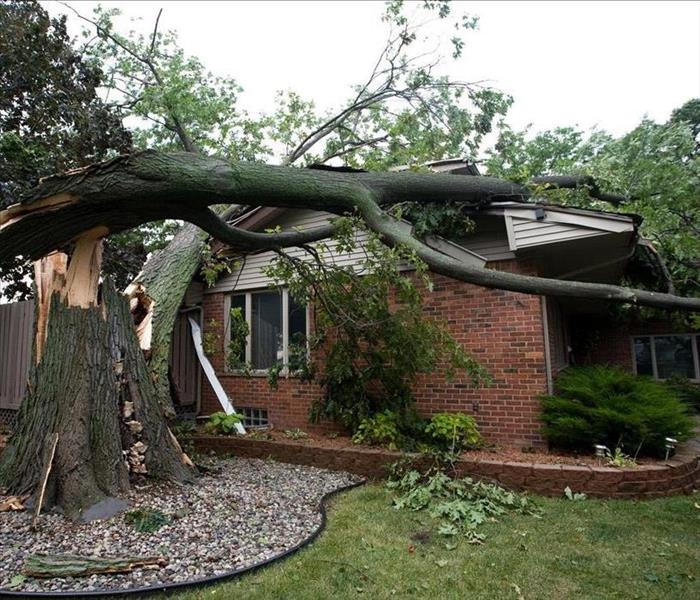Common Storm Damage Scenarios
2/25/2019 (Permalink)
Winter Storm Damage
Winter storms ravage much of the U.S. and Canada every year, and areas that don’t get hit with snow often deal with ice storms and freezing rain. When you’re dealing with blizzards, lake effect storms and snow squalls, damage to your home can include roof and structural damage from heavy snow as well as damage to fascia, exterior pipes and siding. These wintry storms often come with high winds, which can exacerbate damage by causing shingles to break loose. These storms can wreak havoc on utility lines.
Winter storms and freezing weather can also create ice dams, which trap water in between your roof and a layer of ice. These can be easy to miss, but are important to be aware of because they can quickly lead to leaks and then to mold and structural damage.
After a storm, don’t get on the roof or climb into the attic until you’re sure it’s safe. You or your home restoration contractor should check for any signs of leakage in the attic, missing fascia and shingles, bent or detached exhaust pipes, damaged roof vents and damage to the valleys and edges where your roof meets the walls.
When ice storms hit, you may need to be even more cautious. These storms are characterized by leaving at least a quarter of an inch of ice on surfaces. They can cause roofs to collapse, trees to break and power lines to snap. Try to stay in your home until the ice storm has passed and plan ahead with emergency food, water, supplies and power sources.
Hail Damage
Hail damage isn’t always visible. When it is, you can look for cracked shingles, dents in shingles in a random pattern, and bent roof vents and pipes. You can also sustain damage to siding. Invisible damage comes into play when substrate materials beneath the shingles are damaged. If you think you have hail damage, we highly recommend getting an expert opinion. This kind of damage can lead to serious roof leaks that can spread and cause structural problems.
Lightning and Thunderstorm Damage
Lightning storms can occur anywhere in the U.S., and they bring the threat of fires and severe structural damage. Even if your lightning rods work properly by channeling the energy to the ground, it’s possible to see damage to electrical wiring, appliances, antennas, satellite dishes, cable or telephone lines, and steel framework. Unless there are signs of fire, be sure to stay indoors until the storm is over because your home will protect you.
Thunderstorms come with risks even if you aren’t hit by lightning. You could see dangerous flash flooding, hail and high winds.
Storm-related Flood Damage and Tidal Surges
Flooding presents a serious risk to your home and your safety. According to the U.S. National Severe Storms Laboratory, floods kills more people every year than lightning, hurricanes and tornadoes combined.
When it comes to structures, flooding can lead to dangerous contamination and damage to drywall, support beams and foundations. You are at risk for mold within the first 24 hours of a flood, so it’s vital to stop the water from flowing and start remediation quickly.
Different types of floods come with different risks. River floods and flash floods are common when snow melts and have been known to completely overwhelm structures. Coastal floods and storm surges are even more dangerous, and usually lead to evacuation warnings. These can destroy homes entirely, so it’s best to listen to weather reports and plan ahead. Debris flows, which are often made up of heavy mud and plant material, can crush houses and sweep them away.
High Winds, Tornadoes and Hurricane Damage
High winds can occur virtually anywhere, and thousands of tornadoes and hurricanes hit the U.S. every year. Severe winds are defined as exceeding 50-60 mph and are categorized as follows:
Straight-line winds: This broad category includes all winds not associated with rotation
Downdrafts: These winds are small columns of air that sink quickly toward the ground
Downbursts: These winds, which can be as bad as tornadoes, are a result of strong downbursts and are usually associated with thunderstorms
Microbursts: These small, highly concentrated downbursts can exceed 168 mph and can be wet or dry.
Gust fronts: These occur when cold air clashes with warm air from a thunderstorm
Derechos: These long-lived, widespread wind storms come with a band of multiple showers or thunderstorms
Haboobs: These are walls of dust pushed along the ground by thunderstorm downdrafts
Bow echoes: These winds are shaped like an archer’s bow and can produce severe straight-line winds and even tornadoes
Tornadoes: These destructive vortexes can exceed 300 mph and travel over dry land
Cyclones and Hurricanes: In the U.S., these tropical storms rotate inward toward areas of low atmospheric pressure and are most common near the Gulf of Mexico and the eastern seaboard.
Damage from wind can be widespread and can affect not only your structure but also surrounding landscaping and asphalt. Be aware of the potential for falling trees and poles and damaged power lines, and take care of these problems right away. After the storm, examine your property for structural damage to the home, including windows, siding and roofs. In the most extreme scenarios, roofs can be blown clean off.
Hire a Professional Contractor
It’s vital to repair storm damage quickly, but the risk of danger is high. Before you try making repairs yourself, work with your home insurer and hire us, SERVPRO of Milton/Braintree.We are a fully licensed and bonded contractor with credentials from the Institute of Inspection Cleaning and Restoration Certification (IICRC). We’re available for emergencies 24/7.






 24/7 Emergency Service
24/7 Emergency Service
